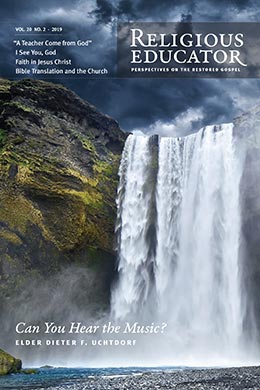Using the Joseph Smith Papers Website: An Introduction
Nathan N. Waite
Nathan N. Waite, "Using the Joseph Smith Papers Website: An Introduction," Religious Educator 20, no. 2 (2019): 104–121.
Nathan N. Waite (waitenn@churchofjesuschrist.org) was an associate editorial manager for the Joseph Smith Papers Project when this was written.
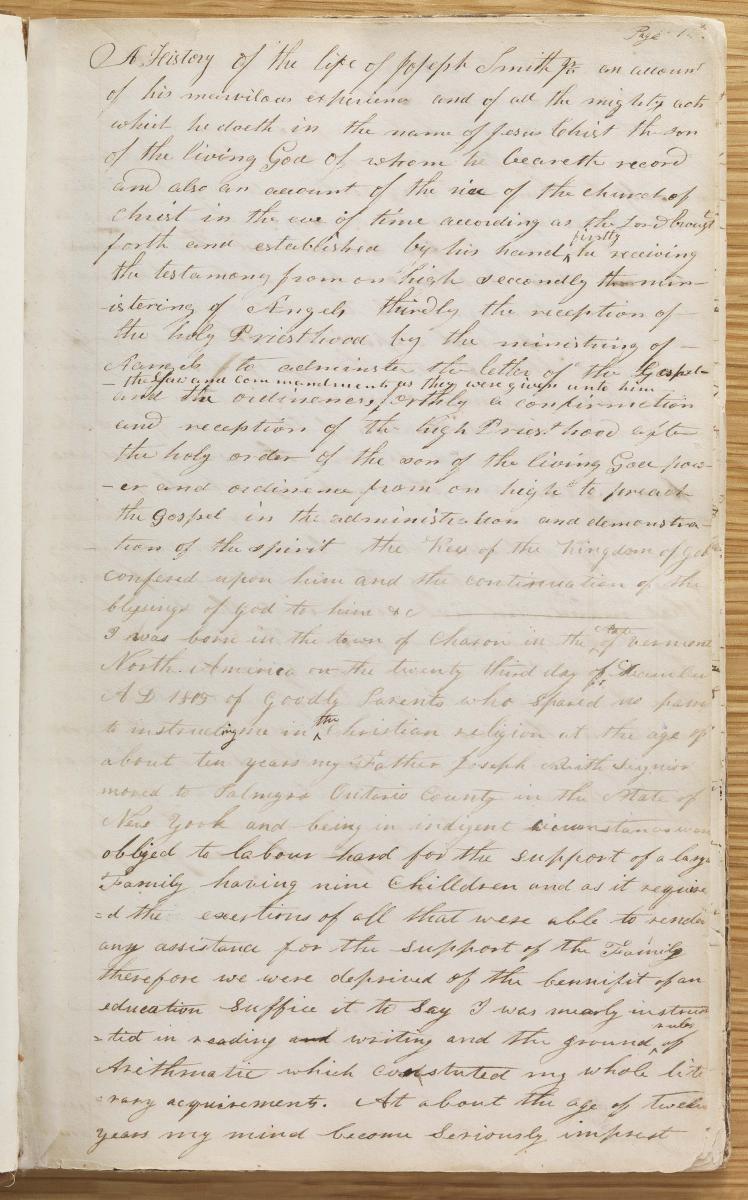 This is the first page of the history Joseph Smith wrote in 1832. In simple, straightforward language it recounts his vision of God the Father and Jesus Christ. This is the earliest written account of Joseph Smith's First Vision–and the only time he ever wrote the story down in his own handwritting.
This is the first page of the history Joseph Smith wrote in 1832. In simple, straightforward language it recounts his vision of God the Father and Jesus Christ. This is the earliest written account of Joseph Smith's First Vision–and the only time he ever wrote the story down in his own handwritting.
There is something special about original historical documents. I have seen it again and again in my own life and in sharing my work on The Joseph Smith Papers with others: people are drawn to the tangible connection to the past provided by these seemingly ordinary, often faded pages. As the Library of Congress puts it, “Primary sources help students relate in a personal way to events of the past and promote a deeper understanding of history as a series of human events.”[1] They inspire people to find out more, to think critically about what they read, and to take responsibility for their own learning.
In the context of the Restoration, history is more than appreciating our shared heritage or learning about important people from the past. It is the continuation of the epic story of the Fall, the Redemption, and our path back to our Heavenly Parents. The records of Church history, including The Joseph Smith Papers, are our link to the events of the Restoration. They are written remnants of God’s hand in the lives of his children, every bit as much as were the stone tablets with the Ten Commandments engraved on them. One valuable source that allows students of Church history to access these original documents is the Joseph Smith Papers website. The purpose of this article is to help religious educators know how to effectively use josephsmithpapers.org to help students better understand the history of the Church and the divine calling of the Prophet Joseph Smith.
The Power of Original Sources
One of my favorite documents in all of Joseph Smith’s papers is the historical essay the Prophet composed with the help of his scribe Frederick G. Williams in 1832. Joseph had purchased a blank book not long before. It had a beautiful tortoiseshell design on the cover, a brown leather spine, and hundreds of crisp lined pages inside, waiting to record his story. He wrote only six pages before discontinuing the project, and the book later became a copybook for letters he sent and received.
In those six pages, though, Joseph and Frederick produced one of the crown jewels of Church history. Joseph starts out with the pen, explaining the moves his family made when he was young and how he did not receive much of a formal education, being “mearly instructtid in reading and writing and the ground rules of Arithmatic.” He talks about his growing preoccupation as a young teenager with “the wellfare of [his] immortal Soul” and goes on to describe his personal scripture study and explorations of religion.[2] Then comes the simple, humble recounting of how he saw God the Father and the Savior of the world with his own eyes. It is the earliest written account of Joseph Smith’s First Vision—and the only time he ever wrote the story down in his own handwriting. The history goes on to recount the visit of the angel Moroni, the discovery of the gold plates, and Joseph’s early attempts at translation.
Besides the marvelous story the document conveys, a small detail of this document makes Joseph Smith come alive to me. On the fifth page, down toward the bottom, Joseph is writing about the divinely prepared interpreters he found buried with the plates—what we have come to know as the Urim and Thummim. Joseph calls them “spectacles” in the history. Actually, he starts by writing a hesitant “spectikke,” then it looks like he goes back and tries to correct the spelling. It is as though he knows something is wrong but does not quite know how to fix it. Finally, he scratches out the whole thing, and it is easy to imagine him turning to his better-educated scribe and asking, “Frederick, how do you spell spectacles?” What follows on the page is the perfectly penned word.[3]
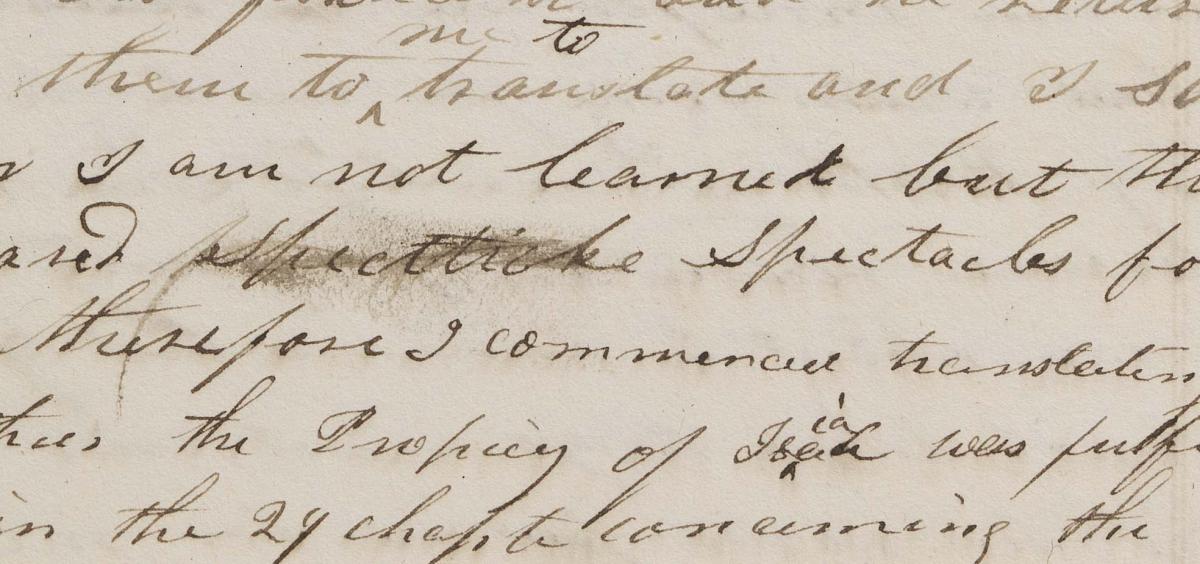 Closeup of page 5 of the 1832 history, showing Joseph Smith’s struggle with spelling.
Closeup of page 5 of the 1832 history, showing Joseph Smith’s struggle with spelling.
In that moment, for me, Joseph becomes a real human being. That page of his earliest history is a window to the past, and it is like the Prophet is sitting in front of me in flesh and blood, struggling to convey his ineffable experiences without the benefits of a stellar education.
Providing Faithful, Accurate Answers
Church leaders have recently emphasized how important it is for religious educators to gain an informed understanding of Church history in order to help students navigate questions they will have. Three years ago, President M. Russell Ballard counseled seminary and institute teachers, “You should be among the first, outside your students’ families, to introduce authoritative sources on topics that may be less well-known or controversial so your students will measure whatever they hear or read later against what you have already taught them.” Educators will be responsible for “providing faithful, thoughtful, and accurate interpretation of gospel doctrine, the scriptures, our history, and those topics that are sometimes misunderstood.” Besides encouraging teachers to know the Gospel Topics essays “like you know the back of your hand,” he counseled, “You should also become familiar with the Joseph Smith Papers website and the Church history section on [churchofjesuschrist.org] and other resources by faithful [Latter-day Saint] scholars.”[4]
In June 2018, in a devotional address to the students at BYU–Idaho, Elder Quentin L. Cook encouraged college students to learn more about Church history by studying materials such as The Joseph Smith Papers. He said, “An integral part of the Joseph Smith Papers Project is its website, josephsmithpapers.org. Here, you will find all of the documents and explanatory material that are in the print volumes. You can see what Joseph Smith’s documents say about topics such as priesthood restoration and the Nauvoo Relief Society. You can see the images of the actual documents, the handwriting of the Prophet and his associates in the work. There is power in being able to see historical documents.”[5]
What Is the Joseph Smith Papers Project?
The Joseph Smith Papers Project is
an effort to gather together all extant Joseph Smith documents and to publish complete and accurate transcripts of those documents with both textual and contextual annotation. All such documents will be published electronically on this website, and a large number of the documents will also be published in print. The print and electronic publications constitute an essential resource for scholars and students of the life and work of Joseph Smith, early Latter-day Saint history, and nineteenth-century American religion. For the first time, all of Joseph Smith’s known surviving papers, which include many of the foundational documents of The Church of Jesus Christ of Latter-day Saints, will be easily accessible in one place.[6]
Though the roots of the work go back more than fifty years, the Joseph Smith Papers Project officially began in 2001 at Brigham Young University and in 2005, transferred to the Church History Library at Church headquarters in Salt Lake City.[7] The first volume, Journals, Vol. 1: 1832–1839, was published in 2008, and the project’s digital edition, josephsmithpapers.org, launched in 2011. The Joseph Smith Papers is an official publication of The Church of Jesus Christ of Latter-day Saints, published by the Church Historian’s Press.[8]
Early in the project, much emphasis was placed on the print edition of The Joseph Smith Papers, and that edition remains the project’s flagship offering. Nineteen volumes have been published to date, with eight more coming in the next few years.
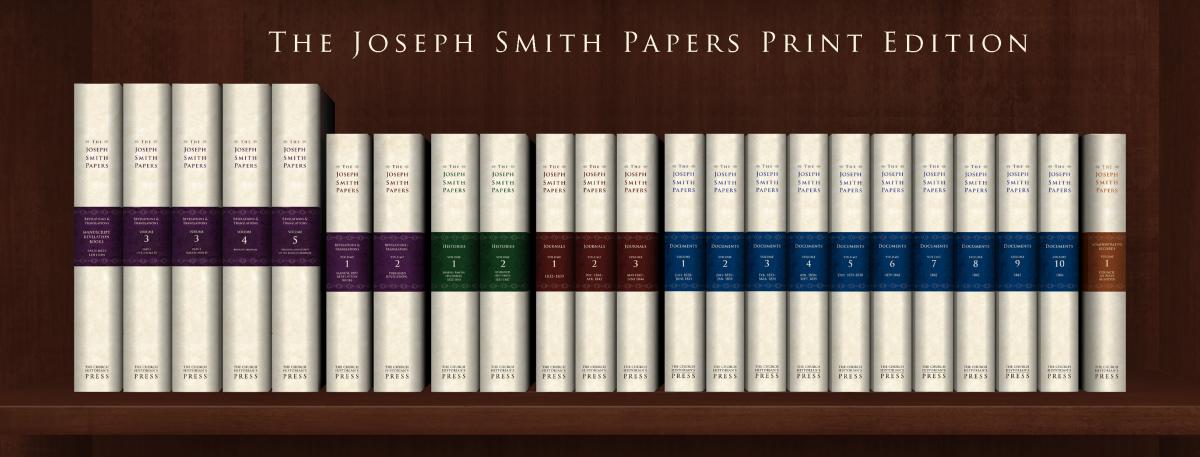 When The Joseph Smith Papers print edition is completed, it will include five series focusing on different aspects of the Prophet Joseph’s documentary record.
When The Joseph Smith Papers print edition is completed, it will include five series focusing on different aspects of the Prophet Joseph’s documentary record.
The audience for the print volumes, however, is necessarily limited—by budget and shelf space. To meet the needs of a wider audience, thousands of documents have been made freely available at josephsmithpapers.org, and that digital version of the project will eventually be a comprehensive collection of Joseph Smith’s documentary record. In 2018, more than half a million people visited the website, demonstrating its reach as a study tool for scholarly specialists and everyday Church members. Users come to the website for a variety of purposes, from academic research on the early days of The Church of Jesus Christ of Latter-day Saints, to checking Joseph Smith quotes for sacrament meeting talks, to downloading images for use in PowerPoint presentations, to looking for information about ancestors.
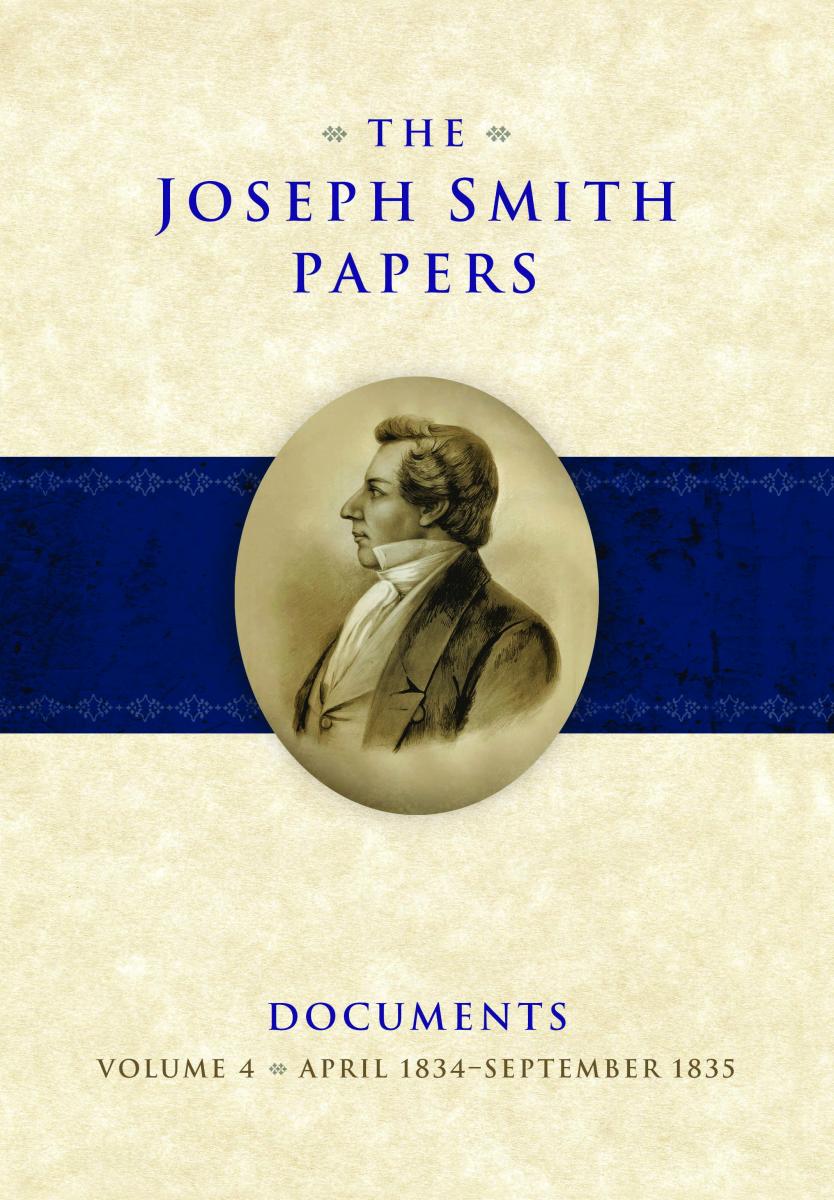 The most recent Joseph Smith Papers print volume is Documents, Volume 8, which chronicles a time of growth in Nauvoo.
The most recent Joseph Smith Papers print volume is Documents, Volume 8, which chronicles a time of growth in Nauvoo.
Both the print and digital editions of The Joseph Smith Papers divide the papers into six different series:
- The Documents series is the backbone of the project, presenting, with the exception of some documents featured in other series, all of Joseph Smith’s papers from the earliest extant document, a July 1828 revelation, to the last thing Joseph wrote, a letter to a lawyer in Quincy, Illinois, penned on the afternoon of 27 June 1844.
- The Journals series presents Joseph Smith’s diaries from 1832 to 1844. His early journals are more sporadic, but many entries were written by Joseph himself; by the 1840s, his journal-keeping was more of a day-by-day endeavor, but one undertaken by scribes on the Prophet’s behalf.
- The Histories series publishes Joseph Smith’s many attempts to record his own story and the story of the Church.
- The Revelations and Translations series provides textual studies of Joseph Smith’s revelatory texts such as the Book of Mormon and the revelations later compiled into the Doctrine and Covenants. You will not find the historical context for individual revelations here (that work is done in the Documents series), but you will find all the minute details of recording and publishing the sacred texts Joseph Smith revealed. Of particular value in this series are the Book of Commandments, various editions of the Doctrine and Covenants, Book of Abraham documents, and the printer’s manuscript of the Book of Mormon.
- The Administrative Records series presents minute books, letter books, and records of organizations Joseph Smith was associated with, such as the Nauvoo Relief Society, Nauvoo City Council, and Council of Fifty.
- The Legal, Business, and Financial Records series presents the legal cases Joseph Smith was involved in as well as the documents related to his business and financial dealings.
The great majority of Joseph Smith’s papers are housed at the Church History Library in Salt Lake City; among the remaining portion, the largest collections are held by the Community of Christ Library and Archives in Independence, Missouri, and by the L. Tom Perry Special Collections at BYU’s Harold B. Lee Library. Other university and private libraries around the country, ranging from the Huntington Library in San Marino, California, to the Beinecke Library at Yale University in New Haven, Connecticut, have documents. Private individuals also hold a number of papers of Joseph Smith. In almost every case, the project has been granted permission to photograph and transcribe documents from these institutions and individuals, so the digital edition represents a virtual gathering of artifacts from dozens of locations separated by thousands of miles. Our warm relationship with the Community of Christ is worth special mention; they have been excellent caretakers of some of the most priceless historical documents of our shared religious heritage and are gracious partners in publishing the records, including the papers relating to Joseph Smith’s work on translating the Bible.
The Joseph Smith Papers Project web team publishes new content every three months. In late 2018, we finished publishing at least one version of every document in the Documents series (many documents have more than one version; for example, an original sent letter may survive as well as a copy made before it was sent). Currently, a primary focus of publication efforts is the Legal, Business, and Financial Records series, and the plan is to publish dozens of introductions briefly contextualizing the court cases that Joseph Smith was involved in as plaintiff, defendant, witness, or judge. More and more versions of revelations will also be published, allowing website users to compare textual variants.
Using the Joseph Smith Papers Website
The main experience on the Joseph Smith Papers website is the document viewer, which presents a high-resolution image of the original document side-by-side with a carefully verified transcript and various editorial additions aimed at enhancing understanding of the document’s production and historical context. (See pp. 112–13) for a graphic explaining the features of the document viewer.)
With each content release, the digital edition of The Joseph Smith Papers grows larger, and navigation can seem increasingly daunting to users who are not familiar with the site. How do you find what you are looking for among the four thousand documents already published on the website? The two main ways of engaging with The Joseph Smith Papers on the website are the search bar at the top of the homepage and the “Browse the Papers” page, where users can navigate the various series. (The next article in this issue explores the search function in more detail.) Project staff members have also developed a number of tools and aids to help users find relevant content. Here are some of those tools:
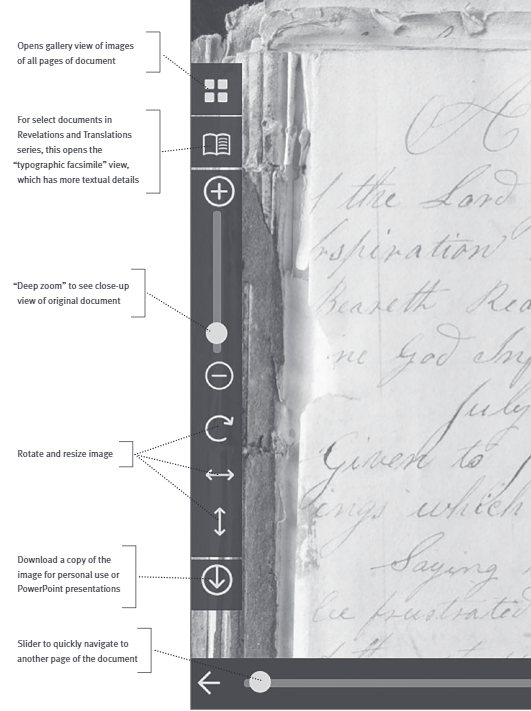
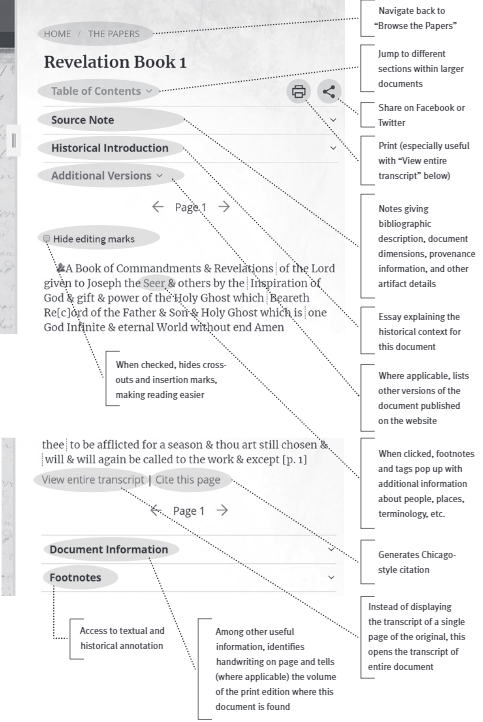
Featured Topics (found at the bottom of the homepage or in the Reference tab). This section of the website gives a brief introduction to frequently searched topics and provides links to relevant Joseph Smith documents. For example, here you will find links to all the accounts of the King Follett discourse, the various Book of Abraham texts, information about Joseph Smith’s involvement in the Female Relief Society of Nauvoo, the accounts of the First Vision (and recent translations of the various accounts into nine languages), and sources on priesthood restoration. One topic article that is especially useful to Church members is “Correlation of Current Doctrine and Covenants with Earliest Sources on the Joseph Smith Papers Website.” Despite its unwieldy title, this article is a helpful resource for studying and teaching the Doctrine and Covenants; it lists every section of the current Doctrine and Covenants with a link to its earliest existing version, a detailed introduction, and extensive footnotes.
People, Places, Events, and Glossary (all under the Reference tab). Aided by missionaries, volunteers, and professional genealogists, the Joseph Smith Papers Project staff has prepared and linked to hundreds of biographical and geographic summaries for the people and places mentioned in Joseph Smith’s papers. The site also provides a chronology of events in Joseph’s life with links to relevant documents, and a glossary that gives readers a sense of what terms like sealing and consecration meant in Joseph’s time—and how the meaning of those terms changed as the early Church grew and developed.
Videos (in the Media tab). Every six months, when a new Joseph Smith Papers print volume is published, the team who worked on the book helps prepare a number of videos that highlight its most meaningful and interesting parts. Take a virtual tour of the Book of Abraham artifacts with Robin Jensen, watch Elizabeth Kuehn explain how women’s sources provide crucial context for The Joseph Smith Papers, or tune in to hear Spencer McBride talk about Joseph’s visit to President Martin Van Buren. There are more than eighty videos currently posted on the website, and their tone and length make them appropriate for use in a Seminary or Institute classroom or for Sunday instruction.
Using the Joseph Smith Papers Site to Add Accuracy to Previously Published Sources
Two often-used sources for Joseph Smith quotes are Joseph Fielding Smith’s The Teachings of the Prophet Joseph Smith and B. H. Roberts’s seven-volume edition of The History of the Church of Jesus Christ of Latter-day Saints: Period 1. History of Joseph Smith, the Prophet, by Himself. These books will continue to be useful and readily available reference works for studying the life and teachings of Joseph Smith, but because they often rely on derivative secondary work for their compilation, they are generally considered outdated sources for scholarly use. The website includes tools intended to help readers of Teachings of the Prophet Joseph Smith and History of the Church get back to the original sources for Joseph Smith teachings and quotes.
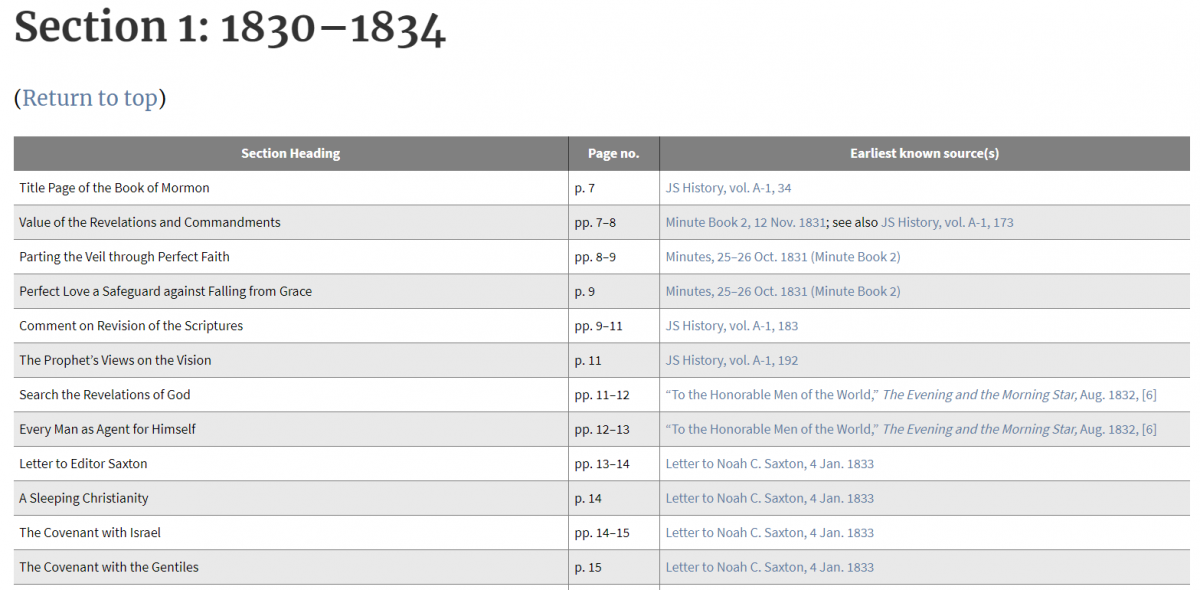
For Teachings of the Prophet Joseph Smith, the fastest way to find original sources is through the article under Featured Topics (josephsmithpapers.org/
page in Joseph Fielding Smith’s publication to the original source at josephsmithpapers.org.
A table on Joseph Smith Papers website links quotes in Teachings of the Prophet Joseph Smith to the original source on the Joseph Smith Papers website.
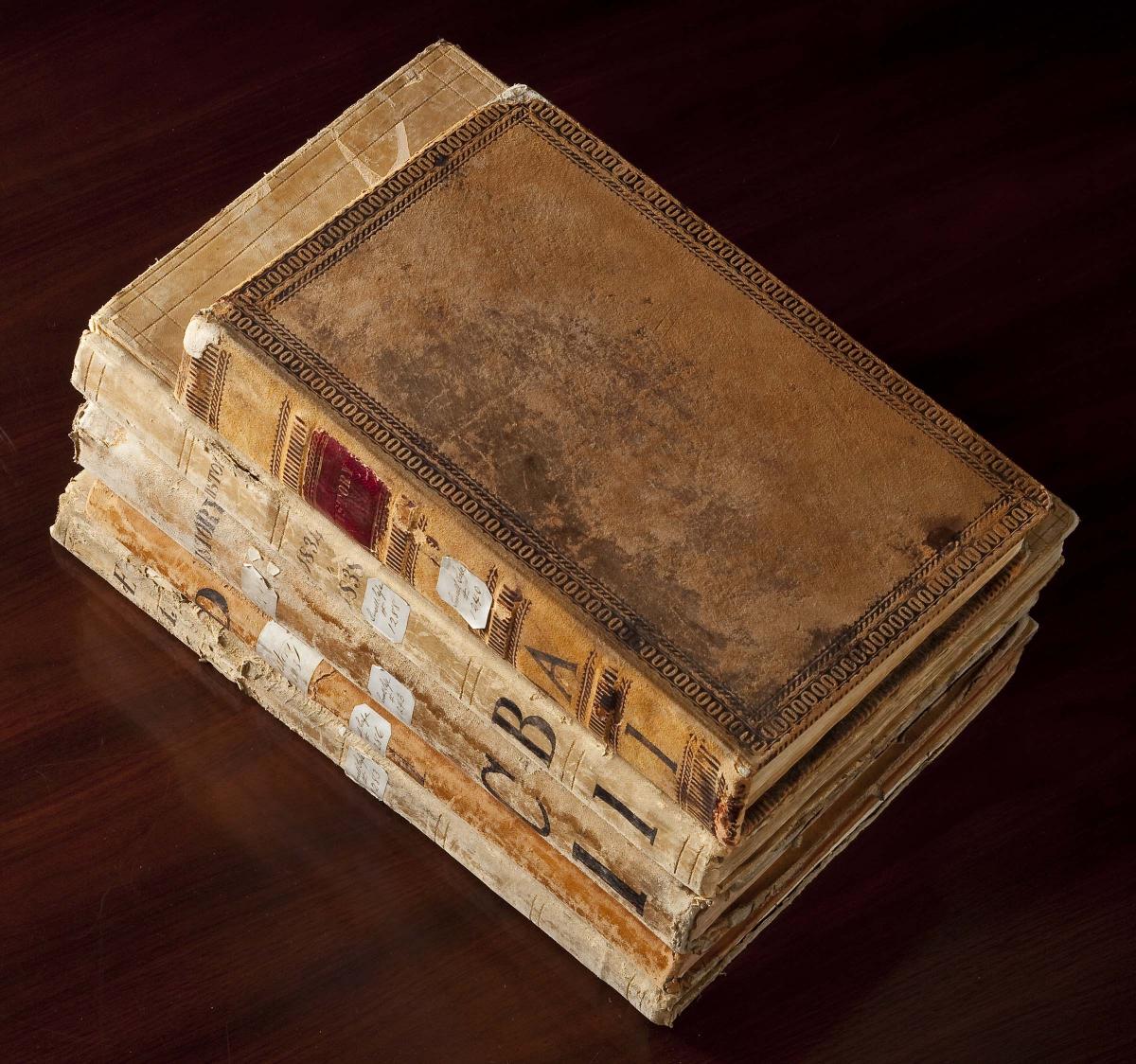 The source behind B. H. Roberts’s History of the Church is a massive manuscript history begun by Joseph Smith in 1838. For the most part, the manuscript consists of handwritten copies of more original sources.
The source behind B. H. Roberts’s History of the Church is a massive manuscript history begun by Joseph Smith in 1838. For the most part, the manuscript consists of handwritten copies of more original sources.
Tracing back from History of the Church requires a little more work. Roberts based his compilation on the serialized “History of Joseph Smith,” published in the Times and Seasons and Deseret News from 1842 to 1858 and in the British Millennial Star from 1842 to 1863. These publications were in turn based on the multivolume manuscript history begun by Joseph Smith in Missouri in 1838 and completed by Historian’s Office clerks in Salt Lake City in 1856, twelve years after Joseph’s death. Although Joseph Smith initiated the history as a narrative chronicling of his life (as excerpted in the Pearl of Great Price), the history soon evolved into a compilation of revelations, letters, journals, minutes, and other documents connected by short narrative passages. The original documents themselves, rather than the derivative text found in the history, are the best sources to use and cite for Joseph Smith’s life and teachings.
The best way to navigate from the B. H. Roberts edition of History of the Church to the original Joseph Smith documents is to start with the article “Corresponding Dates in Versions of the Manuscript History,” found in Featured Topics on the Joseph Smith Papers website. This article includes tables giving dates from Joseph Smith’s life, along with the page number where that date is covered in the manuscript history, where it is found in the serialized newspaper publications, and its page number in History of the Church. Find the page number in the HC column (for History of the Church) and then click the corresponding link in the MHC column (for “Manuscript History of the Church”).Another table on the website gives a side-by-side reference for the various versions of the history Joseph Smith began in 1838, including its serial publication in the Times and Seasons, Deseret News, Millennial Star, and the book publication by B. H. Roberts.
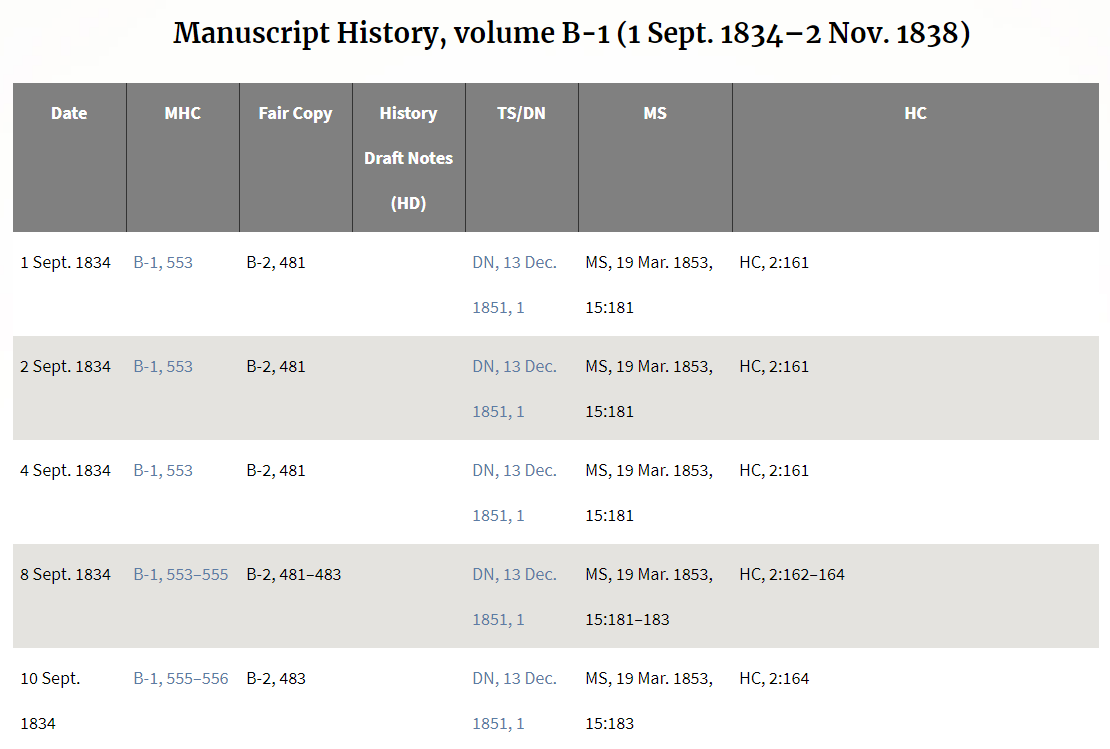
Once you open the manuscript history, footnotes in the text itself identify sources behind the history, with links if the original is on the website.
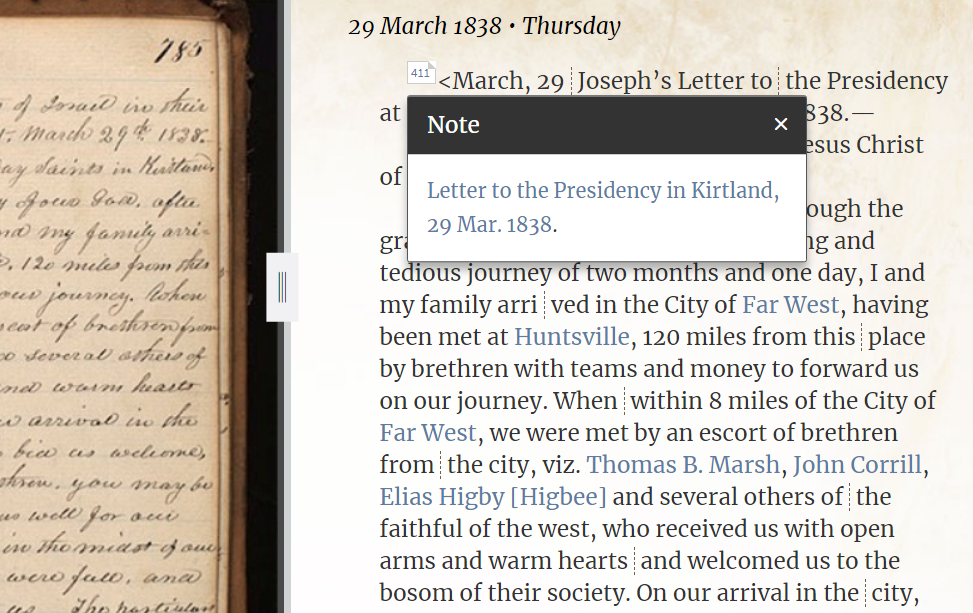 Footnotes in the “Manuscript History of the Church” (which B. H. Roberts published as History of the Church) link readers to the original sources copied into the history.
Footnotes in the “Manuscript History of the Church” (which B. H. Roberts published as History of the Church) link readers to the original sources copied into the history.
Ideas for Teaching
How does a religious educator incorporate the website into classroom instruction and student assignments? The following list gives some ideas, as does the next article in this issue. Some of these suggestions are based on reports from teachers who already use the website in their classrooms. Classes focused on Church history and the Doctrine and Covenants are the most obvious places to incorporate Joseph Smith’s papers into the curriculum, but creative instructors have found wider applications, whether it be introducing the Book of Mormon or the Joseph Smith Translation of the Bible or teaching lessons on any number of gospel topics, from faith, to tithing, to overcoming trials.
Some specific ideas for using the website in the classroom:
- Assign students to read all or portions of Joseph Smith’s 1832–34 journal[9] and to report on what these passages, many of which were written in Joseph’s own hand, reveal about the Prophet’s hopes and desires, character and personality.
- Use images of the incomplete Book of Commandments (discontinued when a mob destroyed the Church’s printing office) as a tangible demonstration of the trials the Saints faced in Jackson County, Missouri, and the courage of Church members like Caroline and Mary Rollins to gather the scattered pages of the book.[10]
- Compare sections 121–23 of the Doctrine and Covenants with Joseph Smith’s original March 1839 letters to the Church, the letters from which these Doctrine and Covenants sections were excerpted.[11] Explore the additional context the original letters provide, and discuss the types of documents contained in the Doctrine and Covenants besides revelations.
- For lesser-known Church history figures mentioned in the Doctrine and Covenants, such as Vienna Jaques, use the “People” page to learn more about their background and their interactions with Joseph Smith.
- Have students read a chapter of the Book of Mormon from the printer’s manuscript;[12] then have them report on how it was different from reading the current edition and what insights they gained from the experience.
- Assign students to read the journal entries from the last two weeks of Joseph Smith’s life and have them write about some of the major themes and events leading up to his death.
- Use the videos about translating the gold plates along with the glossary entries for seer stone (with photographs) and Urim and Thummim to help students understand how the Lord worked through divine means to bring forth the Book of Mormon.
The website is updated on a regular basis, and the web team wants to make it more and more useful to Church members and especially Church educators. If you have suggestions or questions regarding the website, please let us know through either the “Contact Us” link at the bottom of the homepage or through the email feature on the “Project Team” page. To keep up-to-date on the latest publications, consider going to The Joseph Smith Papers homepage and signing up for the project’s newsletter.
I am grateful and excited to live in a time when more information is available about our sacred history than ever before. As students of Church history engage more deeply with original documents and understand their context through resources like The Joseph Smith Papers, they will be better equipped to untangle difficult and sometimes troubling aspects of that history. More importantly, they will see in greater detail the grandeur of the Restoration. They will see how imperfect people worked together to build the kingdom of God, and they will see more clearly their own role in that work.
Notes
[1] “Why Use Primary Sources?,” Library of Congress, www.loc.gov/
[2] Karen Lynn Davidson, David J. Whittaker, Mark Ashurst-McGee, and Richard L. Jensen, eds., Histories, Volume 1: Joseph Smith Histories, 1832–1844, vol. 1 of the Histories series of The Joseph Smith Papers, ed. Dean C. Jessee, Ronald K. Esplin, and Richard Lyman Bushman (Salt Lake City: Church Historian’s Press, 2012), 11; Joseph Smith, “History, ca. Summer 1832,” 1, The Joseph Smith Papers, www.josephsmithpapers.org/
[3] JSP, H1:15; Joseph Smith “History, ca. Summer 1832,” page 5, The Joseph Smith Papers, www.josephsmithpapers.org/
[4] M. Russell Ballard, “The Opportunities and Responsibilities of CES Teachers in the 21st Century,” The Church of Jesus Christ of Latter-day Saints, 26 February 2016, www.churchofjesuschrist.org/
[5] Quentin L. Cook, “Out of Obscurity: How Merciful the Lord Has Been,” BYU–Idaho, 12 June 2018, www.byui.edu/
[6] “About the Project,” The Joseph Smith Papers, josephsmithpapers.org/
[7] Dean C. Jessee, Mark Ashurst-McGee, and Richard L. Jensen, eds., Journals, Volume 1: 1832–1839, vol. 1 of the Journals series of The Joseph Smith Papers, ed. Dean C. Jessee, Ronald K. Esplin, and Richard Lyman Bushman (Salt Lake City: Church Historian’s Press, 2008), xl; “Joseph Smith and His Papers,” The Joseph Smith Papers, www.josephsmithpapers.org/
[8] See, for example, “Landmark Publication Launches: Inaugural Volume of Joseph Smith Papers Now Available,” Newsroom, 1 December 2008, https://
[9] Found in the “Journals” tab or at “Journal, 1832–1834,” The Joseph Smith Papers, www.josephsmithpapers.org/
[10] Find it under the “Revelations and Translations” tab or at “Book of Commandments, 1833,” The Joseph Smith Papers, www.josephsmithpapers.org/
[11] Start with “Letter to the Church and Edward Partridge, 20 March 1839,” The Joseph Smith Papers, www.josephsmithpapers.org/
[12] Found in the “Revelation and Translations” tab or at “Printer’s Manuscript of the Book of Mormon, circa August 1820–circa January 1830,” The Joseph Smith Papers, www.josephsmithpapers.org/
